Data Fusion for Estimating High-Resolution Urban Heatwave Air Temperature
Abstract
1. Introduction
2. Study Area and Datasets
2.1. Study Area
2.2. Datasets
2.2.1. Temperature Products
2.2.2. Topographical and Geographical Products
2.3. Data Pre-Processing
3. Two-Step Data Fusion Model
3.1. Overall Framework
3.2. Genetic Programming (GP) Algorithm
3.3. Model Fitting and Statistical Indicators
4. Results and Discussions
4.1. The Performance of Regression Models
4.2. Inadequacies of ERA5-Land Data during Downscaling
4.3. Challenges Posed by Water Bodies
4.4. The Results of Forward Stepwise Regression
4.5. Limitations of the Research
5. Conclusions
Author Contributions
Funding
Data Availability Statement
Conflicts of Interest
References
- Xu, Z.; FitzGerald, G.; Guo, Y.; Jalaludin, B.; Tong, S. Impact of heatwave on mortality under different heatwave definitions: A systematic review and meta-analysis. Environ. Int. 2016, 89, 193–203. [Google Scholar] [CrossRef] [PubMed]
- Wang, P.; Tang, J.; Sun, X.; Wang, S.; Wu, J.; Dong, X.; Fang, J. Heat waves in China: Definitions, leading patterns, and connections to large-scale atmospheric circulation and SSTs. J. Geophys. Res. Atmos. 2017, 122, 10679–10699. [Google Scholar] [CrossRef]
- Perkins-Kirkpatrick, S.; Lewis, S. Increasing trends in regional heatwaves. Nat. Commun. 2020, 11, 3357. [Google Scholar] [CrossRef] [PubMed]
- Cred; UNDRR. Human Cost of Disasters. An Overview of the Last 20 Years: 2000–2019; CRED: Bengaluru, India; UNDRR: Geneva, Switzerland, 2020. [Google Scholar]
- Tomlinson, C.J.; Chapman, L.; Thornes, J.E.; Baker, C.J. Including the urban heat island in spatial heat health risk assessment strategies: A case study for Birmingham, UK. Int. J. Health Geogr. 2011, 10, 42. [Google Scholar] [CrossRef] [PubMed]
- NCD-RisC. Rising rural body-mass index is the main driver of the global obesity epidemic in adults. Nature 2019, 569, 260–264. [Google Scholar] [CrossRef] [PubMed]
- Chen, K.; Bi, J.; Chen, J.; Chen, X.; Huang, L.; Zhou, L. Influence of heat wave definitions to the added effect of heat waves on daily mortality in Nanjing, China. Sci. Total Environ. 2015, 506, 18–25. [Google Scholar] [CrossRef]
- Abunnasr, Y.; Mhawej, M. Downscaled night air temperatures between 2030 and 2070: The case of cities with a complex- and heterogeneous-topography. Urban Clim. 2021, 40, 100998. [Google Scholar] [CrossRef]
- He, C.; Ma, L.; Zhou, L.; Kan, H.; Zhang, Y.; Ma, W.; Chen, B. Exploring the mechanisms of heat wave vulnerability at the urban scale based on the application of big data and artificial societies. Environ. Int. 2019, 127, 573–583. [Google Scholar] [CrossRef]
- Loughran, T.F.; Pitman, A.J.; Perkins-Kirkpatrick, S.E. The El Niño–Southern Oscillation’s effect on summer heatwave development mechanisms in Australia. Clim. Dyn. 2019, 52, 6279–6300. [Google Scholar] [CrossRef]
- Zou, J.; Lu, N.; Jiang, H.; Qin, J.; Yao, L.; Xin, Y.; Su, F. Performance of air temperature from ERA5-Land reanalysis in coastal urban agglomeration of Southeast China. Sci. Total Environ. 2022, 828, 154459. [Google Scholar] [CrossRef]
- Shen, H.; Huang, L.; Zhang, L.; Wu, P.; Zeng, C. Long-term and fine-scale satellite monitoring of the urban heat island effect by the fusion of multi-temporal and multi-sensor remote sensed data: A 26-year case study of the city of Wuhan in China. Remote Sens. Environ. 2016, 172, 109–125. [Google Scholar] [CrossRef]
- Castanedo, F. A review of data fusion techniques. Sci. World J. 2013, 2013, 704504. [Google Scholar] [CrossRef] [PubMed]
- Esteban, J.; Starr, A.; Willetts, R.; Hannah, P.; Bryanston-Cross, P. A review of data fusion models and architectures: Towards engineering guidelines. Neural Comput. Appl. 2005, 14, 273–281. [Google Scholar] [CrossRef]
- Dos Santos, R.S. Estimating spatio-temporal air temperature in London (UK) using machine learning and earth observation satellite data. Int. J. Appl. Earth Obs. Geoinf. 2020, 88, 102066. [Google Scholar] [CrossRef]
- Wakjira, M.T.; Peleg, N.; Burlando, P.; Molnar, P. Gridded daily 2-m air temperature dataset for Ethiopia derived by debiasing and downscaling ERA5-Land for the period 1981–2010. Data Brief 2023, 46, 108844. [Google Scholar] [CrossRef]
- Viggiano, M.; Busetto, L.; Cimini, D.; Di Paola, F.; Geraldi, E.; Ranghetti, L.; Ricciardelli, E.; Romano, F. A new spatial modeling and interpolation approach for high-resolution temperature maps combining reanalysis data and ground measurements. Agric. For. Meteorol. 2019, 276, 107590. [Google Scholar] [CrossRef]
- Karaman, Ç.H.; Akyürek, Z. Evaluation of Near-surface Air Temperature Reanalysis Datasets and Downscaling with Machine Learning based Random Forest Method for Complex Terrain of Turkey. Adv. Space Res. 2023, 71, 5256–5281. [Google Scholar] [CrossRef]
- Zhu, X.; Zhang, Q.; Xu, C.-Y.; Sun, P.; Hu, P. Reconstruction of high spatial resolution surface air temperature data across China: A new geo-intelligent multisource data-based machine learning technique. Sci. Total Environ. 2019, 665, 300–313. [Google Scholar] [CrossRef]
- Shen, H.; Jiang, Y.; Li, T.; Cheng, Q.; Zeng, C.; Zhang, L. Deep learning-based air temperature mapping by fusing remote sensing, station, simulation and socioeconomic data. Remote Sens. Environ. 2020, 240, 111692. [Google Scholar] [CrossRef]
- Zhang, H.; Immerzeel, W.; Zhang, F.; De Kok, R.J.; Gorrie, S.J.; Ye, M. Creating 1-km long-term (1980–2014) daily average air temperatures over the Tibetan Plateau by integrating eight types of reanalysis and land data assimilation products downscaled with MODIS-estimated temperature lapse rates based on machine learning. Int. J. Appl. Earth Obs. Geoinf. 2021, 97, 102295. [Google Scholar] [CrossRef]
- Zhang, X.; Huang, T.; Gulakhmadov, A.; Song, Y.; Gu, X.; Zeng, J.; Huang, S.; Nam, W.-H.; Chen, N.; Niyogi, D. Deep Learning-Based 500 m Spatio-Temporally Continuous Air Temperature Generation by Fusing Multi-Source Data. Remote Sens. 2022, 14, 3536. [Google Scholar] [CrossRef]
- Javed, M.F.; Amin, M.N.; Shah, M.I.; Khan, K.; Iftikhar, B.; Farooq, F.; Aslam, F.; Alyousef, R.; Alabduljabbar, H. Applications of gene expression programming and regression techniques for estimating compressive strength of bagasse ash based concrete. Crystals 2020, 10, 737. [Google Scholar] [CrossRef]
- Stanislawska, K.; Krawiec, K.; Kundzewicz, Z.W. Modeling global temperature changes with genetic programming. Comput. Math. Appl. 2012, 64, 3717–3728. [Google Scholar] [CrossRef]
- Coulibaly, P.J.G.R.L. Downscaling daily extreme temperatures with genetic programming. Geophys. Res. Lett. 2004, 31, L16203. [Google Scholar] [CrossRef]
- Beckett, A.D.; Sanderson, M.G. Analysis of historical heatwaves in the United Kingdom using gridded temperature data. Int. J. Climatol. 2022, 42, 453–464. [Google Scholar] [CrossRef]
- Ryan, R.G.; Marais, E.A.; Gershenson-Smith, E.; Ramsay, R.; Muller, J.-P.; Tirpitz, J.-L.; Frieß, U. Measurement Report: MAX-DOAS measurements characterise Central London ozone pollution episodes during 2022 heatwaves. Atmos. Chem. Phys. 2023, 23, 7121–7139. [Google Scholar] [CrossRef]
- Arbuthnott, K.G.; Hajat, S. The health effects of hotter summers and heat waves in the population of the United Kingdom: A review of the evidence. Environ. Health 2017, 16, 119. [Google Scholar] [CrossRef]
- UKHSA. Heatwave Plan for England. 2014. Available online: https://www.gov.uk/government/publications/heatwave-plan-for-england (accessed on 8 December 2022).
- Green, H.K.; Andrews, N.; Armstrong, B.; Bickler, G.; Pebody, R. Mortality during the 2013 heatwave in England–how did it compare to previous heatwaves? A retrospective observational study. Environ. Res. 2016, 147, 343–349. [Google Scholar] [CrossRef]
- Rustemeyer, N.; Howells, M. Excess mortality in England during the 2019 summer heatwaves. Climate 2021, 9, 14. [Google Scholar] [CrossRef]
- Thompson, R.; Landeg, O.; Kar-Purkayastha, I.; Hajat, S.; Kovats, S.; O’Connell, E. Heatwave mortality in summer 2020 in England: An observational study. Int. J. Environ. Res. Public Health 2022, 19, 6123. [Google Scholar] [CrossRef]
- Jin, M.; Liang, S. An improved land surface emissivity parameter for land surface models using global remote sensing observations. J. Clim. 2006, 19, 2867–2881. [Google Scholar] [CrossRef]
- Thapa, S.; Rudd, J.C.; Xue, Q.; Bhandari, M.; Reddy, S.K.; Jessup, K.E.; Liu, S.; Devkota, R.N.; Baker, J.; Baker, S. Use of NDVI for characterizing winter wheat response to water stress in a semi-arid environment. J. Crop Improv. 2019, 33, 633–648. [Google Scholar] [CrossRef]
- Jacobs, C.; Klok, L.; Bruse, M.; Cortesão, J.; Lenzholzer, S.; Kluck, J. Are urban water bodies really cooling? Urban Clim. 2020, 32, 100607. [Google Scholar] [CrossRef]
- Szabo, S.; Gácsi, Z.; Balazs, B. Specific features of NDVI, NDWI and MNDWI as reflected in land cover categories. Landsc. Environ. 2016, 10, 194–202. [Google Scholar] [CrossRef]
- Kaplan, G.; Avdan, Z.Y.; Avdan, U. Mapping and monitoring wetland dynamics using thermal, optical, and SAR remote sensing data. Sustain. Solut. 2019, 87, 86–107. [Google Scholar] [CrossRef]
- Kerr, Y.H.; Lagouarde, J.P.; Imbernon, J. Accurate land surface temperature retrieval from AVHRR data with use of an improved split window algorithm. Remote Sens. Environ. 1992, 41, 197–209. [Google Scholar] [CrossRef]
- Jin, Z.; Ma, Y.; Chu, L.; Liu, Y.; Dubrow, R.; Chen, K. Predicting spatiotemporally-resolved mean air temperature over Sweden from satellite data using an ensemble model. Environ. Res. 2022, 204, 111960. [Google Scholar] [CrossRef]
- Li, X.; Zhou, Y.; Asrar, G.R.; Zhu, Z. Developing a 1 km resolution daily air temperature dataset for urban and surrounding areas in the conterminous United States. Remote Sens. Environ. 2018, 215, 74–84. [Google Scholar] [CrossRef]
- Williamson, S.N.; Hik, D.S.; Gamon, J.A.; Kavanaugh, J.L.; Flowers, G.E. Estimating temperature fields from MODIS land surface temperature and air temperature observations in a sub-arctic alpine environment. Remote Sens. 2014, 6, 946–963. [Google Scholar] [CrossRef]
- Lin, X.; Zhang, W.; Huang, Y.; Sun, W.; Han, P.; Yu, L.; Sun, F. Empirical estimation of near-surface air temperature in China from MODIS LST data by considering physiographic features. Remote Sens. 2016, 8, 629. [Google Scholar] [CrossRef]
- Shi, Y.; Jiang, Z.; Dong, L.; Shen, S. Statistical estimation of high-resolution surface air temperature from MODIS over the Yangtze River Delta, China. J. Meteorol. Res. 2017, 31, 448–454. [Google Scholar] [CrossRef]
- Schumacher, D.L.; Keune, J.; Van Heerwaarden, C.C.; Vilà-Guerau de Arellano, J.; Teuling, A.J.; Miralles, D.G. Amplification of mega-heatwaves through heat torrents fuelled by upwind drought. Nat. Geosci. 2019, 12, 712–717. [Google Scholar] [CrossRef]
- Abonyi, J. Genetic Programming MATLAB Toolbox. 2022. Available online: https://www.mathworks.com/matlabcentral/fileexchange/47197-genetic-programming-matlab-toolbox (accessed on 3 December 2022).
- Madár, J.; Abonyi, J.; Szeifert, F.J.I. Genetic programming for the identification of nonlinear input-output models. Eng. Chem. Res. 2005, 44, 3178–3186. [Google Scholar] [CrossRef]
- Kim, J.-H. Estimating classification error rate: Repeated cross-validation, repeated hold-out and bootstrap. Comput. Stat. Data Anal. 2009, 53, 3735–3745. [Google Scholar] [CrossRef]
- Doornik, J.A. Encompassing and automatic model selection. Oxf. Bull. Econ. Stat. 2008, 70, 915–925. [Google Scholar] [CrossRef]
- Janatian, N.; Sadeghi, M.; Sanaeinejad, S.H.; Bakhshian, E.; Farid, A.; Hasheminia, S.M.; Ghazanfari, S. A statistical framework for estimating air temperature using MODIS land surface temperature data. Int. J. Climatol. 2017, 37, 1181–1194. [Google Scholar] [CrossRef]
- Zhou, B.; Erell, E.; Hough, I.; Rosenblatt, J.; Just, A.C.; Novack, V.; Kloog, I. Estimating near-surface air temperature across Israel using a machine learning based hybrid approach. Int. J. Climatol. 2020, 40, 6106–6121. [Google Scholar] [CrossRef]
- Zhou, S.; Wang, Y.; Yuan, Q. Estimation of Hourly Air Temperature in China Based on LightGBM and Himawari-8. In Proceedings of the IGARSS 2022—2022 IEEE International Geoscience and Remote Sensing Symposium, Kuala Lumpur, Malaysia, 17–22 July 2022. [Google Scholar] [CrossRef]
- Chen, G.; Shi, Y.; Wang, R.; Ren, C.; Ng, E.; Fang, X.; Ren, Z. Integrating weather observations and local-climate-zone-based landscape patterns for regional hourly air temperature mapping using machine learning. Sci. Total Environ. 2022, 841, 156737. [Google Scholar] [CrossRef]
- Chen, S.; Yang, Y.; Deng, F.; Zhang, Y.; Liu, D.; Liu, C.; Gao, Z. A high-resolution monitoring approach of canopy urban heat island using a random forest model and multi-platform observations. Atmos. Meas. Tech. 2022, 15, 735–756. [Google Scholar] [CrossRef]
- Carrión, D.; Arfer, K.B.; Rush, J.; Dorman, M.; Rowland, S.T.; Kioumourtzoglou, M.-A.; Kloog, I.; Just, A.C. A 1-km hourly air-temperature model for 13 northeastern US states using remotely sensed and ground-based measurements. Environ. Res. 2021, 200, 111477. [Google Scholar] [CrossRef]
- Huang, X.; Han, S.; Shi, C. Multiscale Assessments of Three Reanalysis Temperature Data Systems over China. Agriculture 2021, 11, 1292. [Google Scholar] [CrossRef]
- Subhanil, G.; Govil, H. Relationship between land surface temperature and normalized difference water index on various land surfaces: A seasonal analysis. Int. J. Eng. Geosci. 2021, 6, 165–173. [Google Scholar] [CrossRef]
- Hathway, E.; Sharples, S. The interaction of rivers and urban form in mitigating the Urban Heat Island effect: A UK case study. Build. Environ. 2012, 58, 14–22. [Google Scholar] [CrossRef]
- Wan, Z.; Li, Z.-L. A physics-based algorithm for retrieving land-surface emissivity and temperature from EOS/MODIS data. IEEE Trans. Geosci. Remote Sens. 1997, 35, 980–996. [Google Scholar] [CrossRef]
- Rights, J.D.; Sterba, S.K. Quantifying explained variance in multilevel models: An integrative framework for defining R-squared measures. Psychol. Methods 2019, 24, 309. [Google Scholar] [CrossRef] [PubMed]
- Jia, S.; Zhu, W.; Lű, A.; Yan, T. A statistical spatial downscaling algorithm of TRMM precipitation based on NDVI and DEM in the Qaidam Basin of China. Remote Sens. Environ. 2011, 115, 3069–3079. [Google Scholar] [CrossRef]
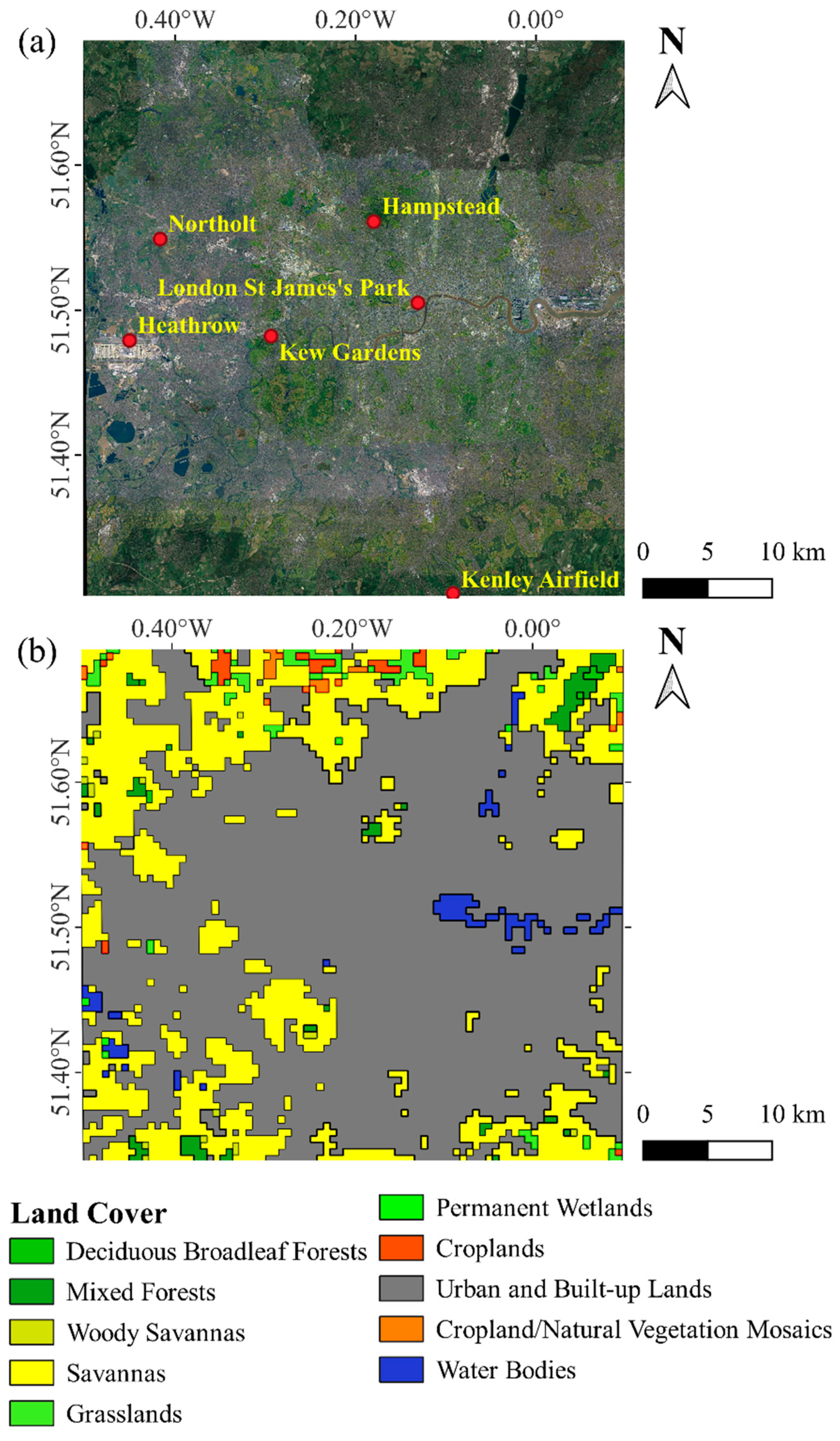
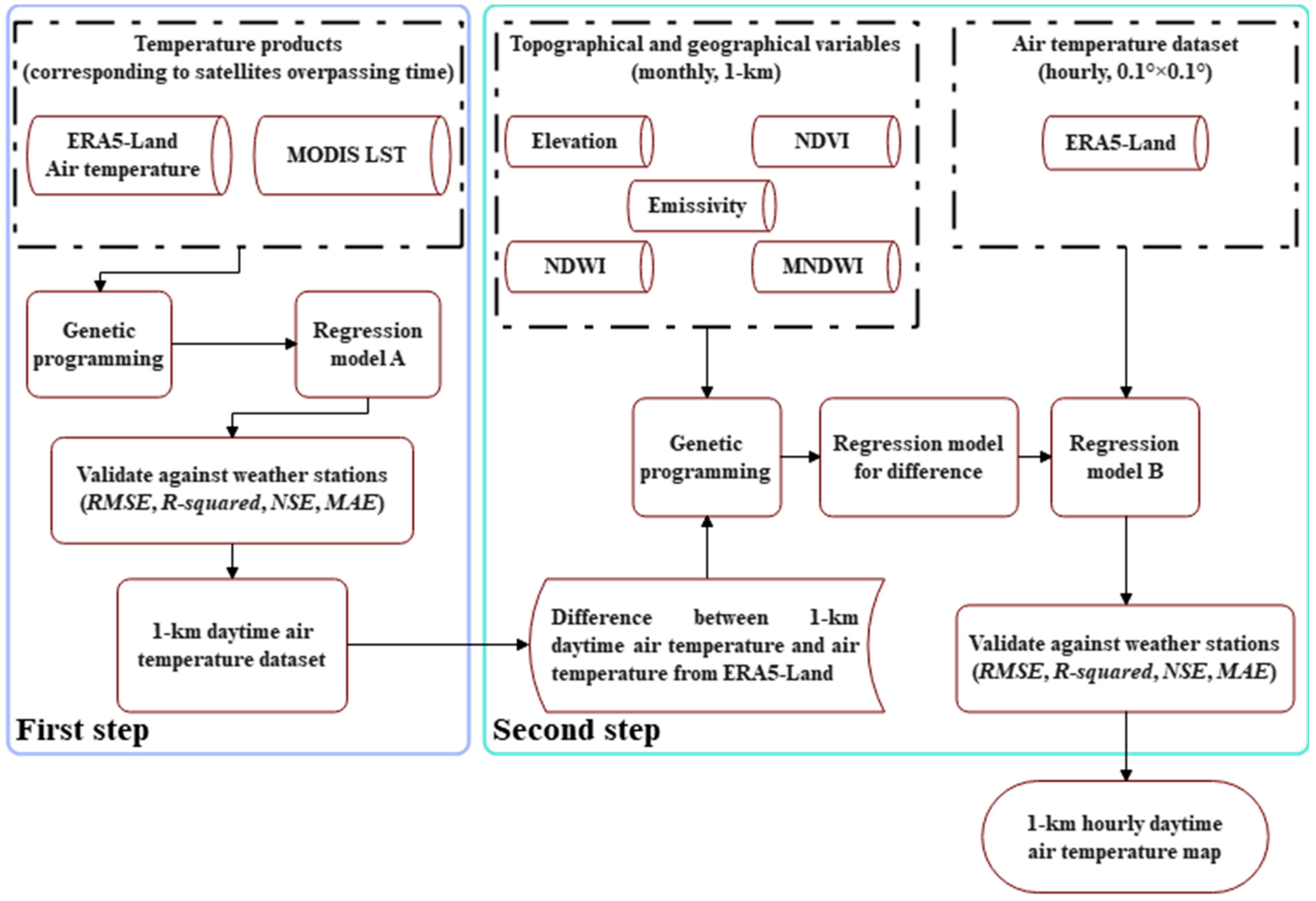
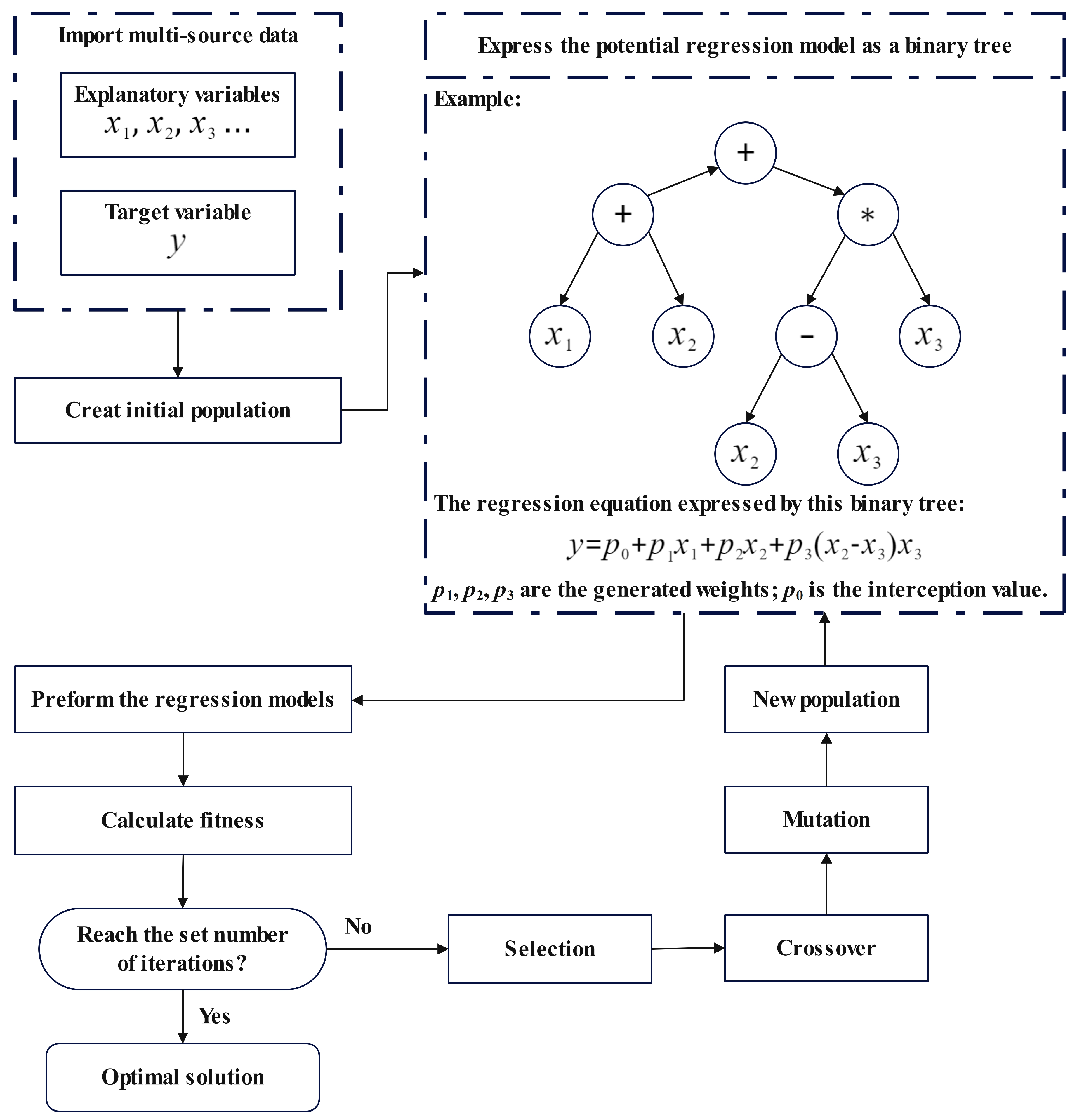

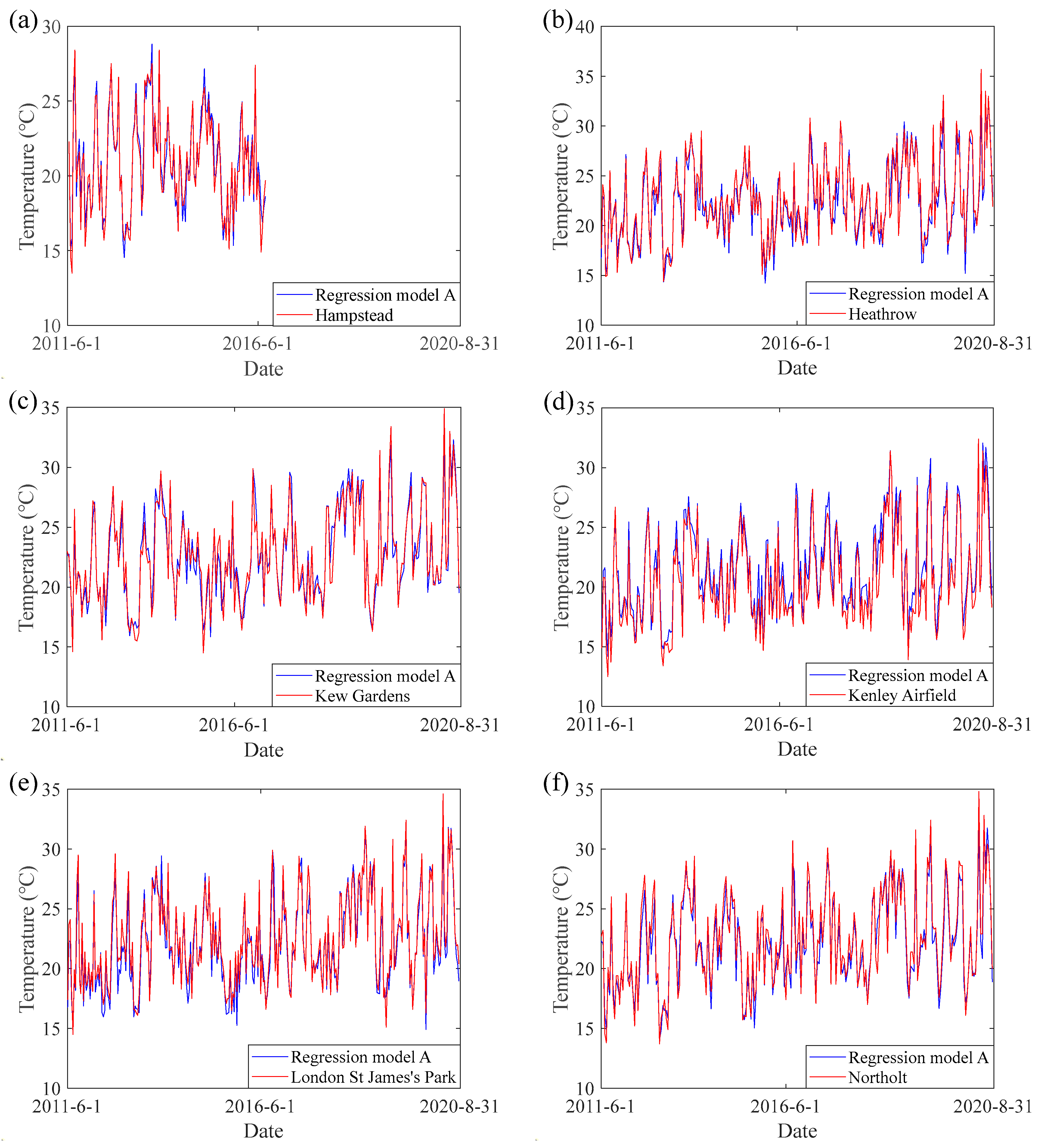
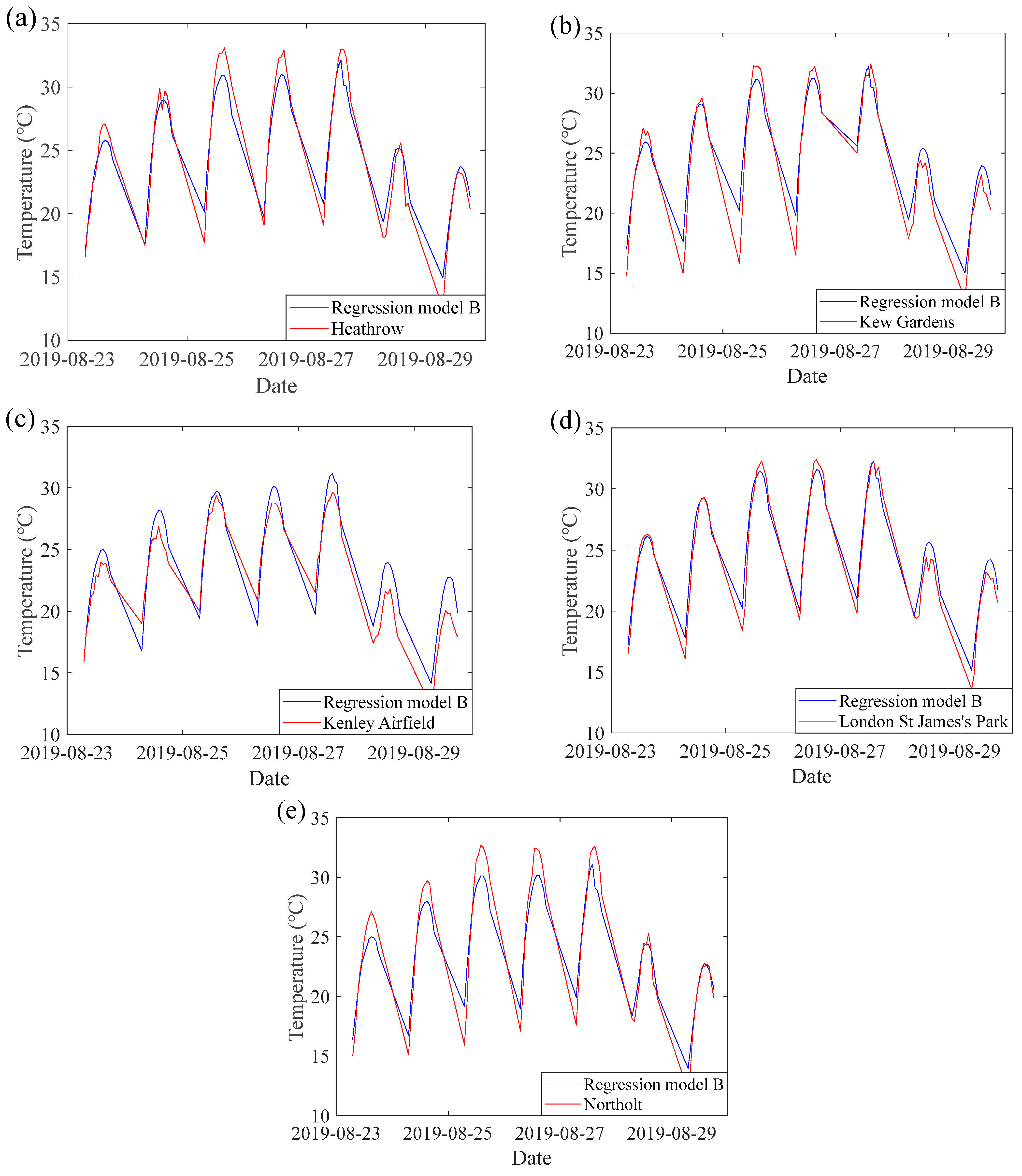
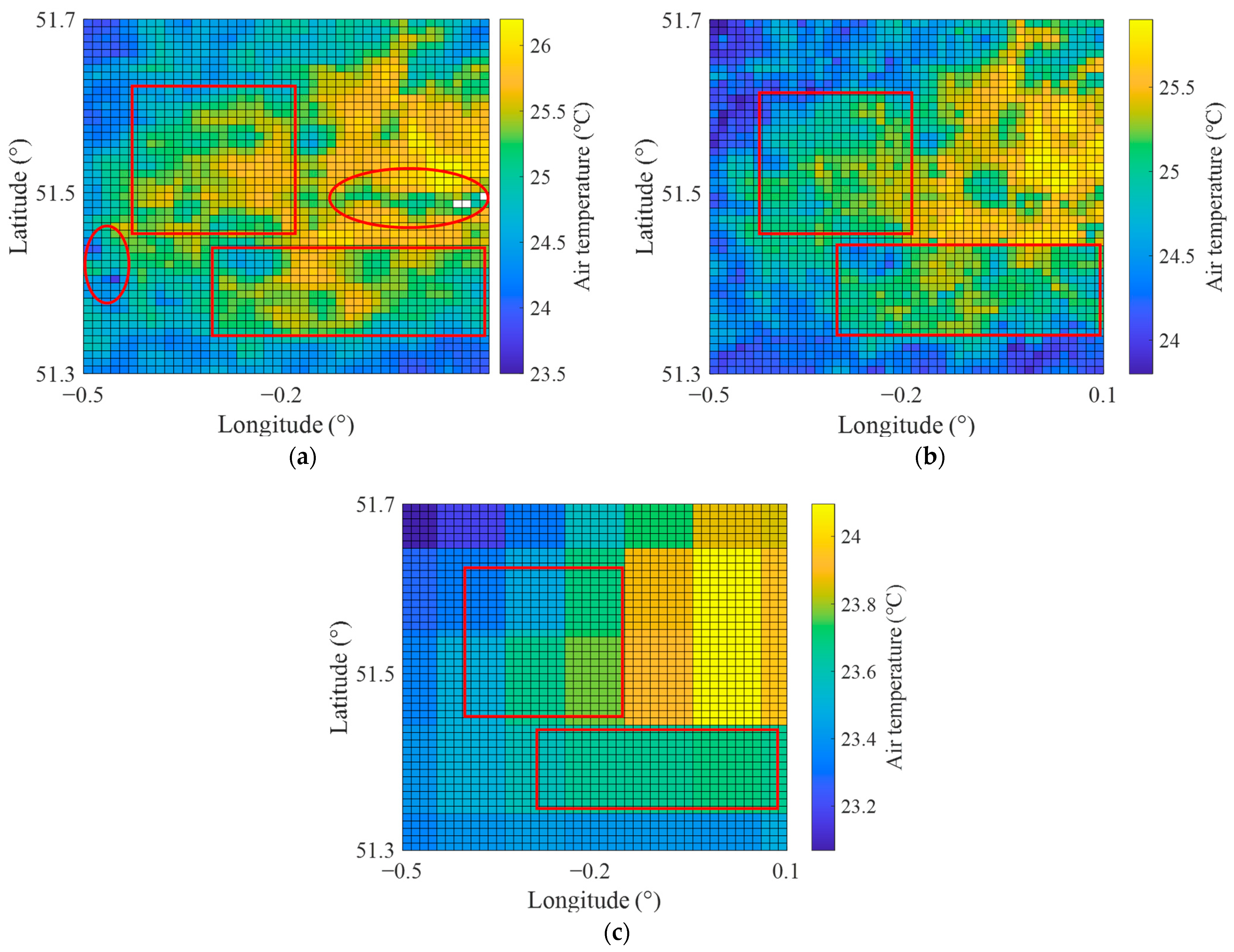

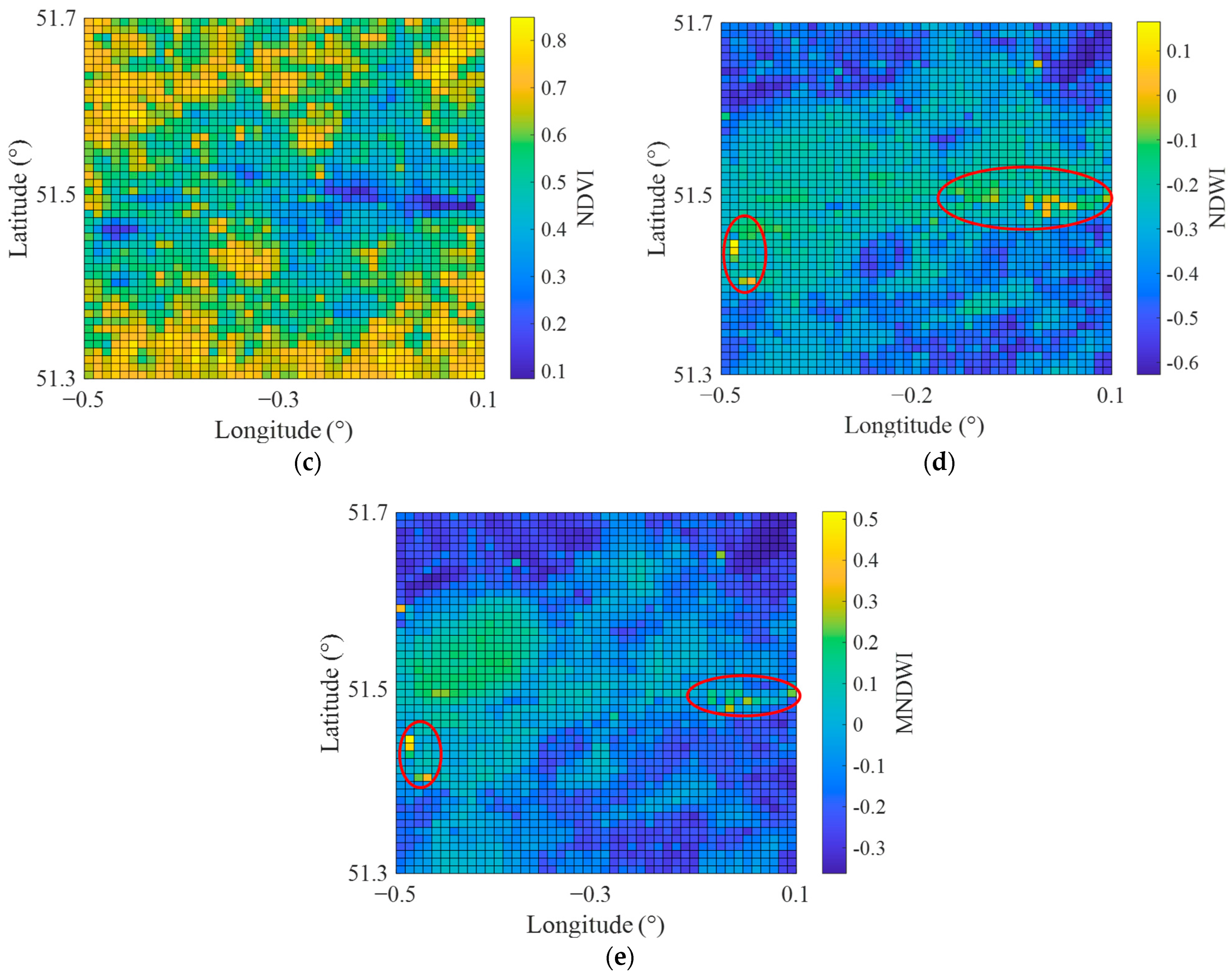
| No. | Start Date | End Date | Maximum CET (°C) | Source |
|---|---|---|---|---|
| 1 | 11 July 2013 | 24 July 2013 | 28.1 | [30] |
| 2 | 28 June 2019 | 30 June 2019 | 30.6 | [31] |
| 3 | 21 July 2019 | 28 July 2019 | 34.1 | [31] |
| 4 | 23 August 2019 | 29 August 2019 | 29.9 | [31] |
| 5 | 23 June 2020 | 27 June 2020 | 29.4 | [32] |
| Data Type | Source | Product | Temporal Resolution | Spatial Resolution |
|---|---|---|---|---|
| Temperature products | ERA5-Land | Air temperature | Hourly | 0.1° × 0.1° |
| MODIS | LST | Daily | 1 km | |
| Open data version of met office integrated data archive system (MIDAS-Open) | Air temperature | Hourly | Point | |
| Topographical and geographic products | Shuttle radar topography mission (SRTM) | DEM | / | 90 m |
| MODIS | Emissivity | 8 days | 1 km | |
| MODIS | NDVI | 16 days | 1 km | |
| Landsat 8 | NDWI | 8 days | 30 m | |
| Landsat 8 | MNDWI | 8 days | 30 m |
| Initial Population Size | Maximum Tree Depth | Crossover Probability | Mutation Probability | Selection Type | Iterations Number |
|---|---|---|---|---|---|
| 500 | 15 | 0.7 | 0.3 | Tournament selection | 30 |
| Stations | R-squared | RMSE (°C) | MAE (°C) | NSE |
|---|---|---|---|---|
| Hampstead | 0.941 | 0.158 | 0.616 | 0.939 |
| Heathrow | 0.925 | 0.288 | 0.957 | 0.920 |
| Kenley Airfield | 0.954 | 1.110 | 1.175 | 0.892 |
| Kew Gardens | 0.950 | 0.015 | 0.706 | 0.950 |
| London St James’s Park | 0.953 | 0.300 | 0.739 | 0.946 |
| Northolt | 0.933 | 0.140 | 0.841 | 0.932 |
| Full validation set (all stations) | 0.931 | 0.070 | 0.884 | 0.930 |
| Stations | R-squared | RMSE (°C) | MAE (°C) | NSE |
|---|---|---|---|---|
| Hampstead | 0.931 | 0.821 | 1.203 | 0.889 |
| Heathrow | 0.973 | 0.113 | 1.015 | 0.939 |
| Kenley Airfield | 0.917 | 1.055 | 1.374 | 0.856 |
| Kew Gardens | 0.965 | 0.518 | 1.108 | 0.925 |
| London St James’s Park | 0.978 | 0.463 | 0.821 | 0.955 |
| Northolt | 0.969 | 0.400 | 1.279 | 0.916 |
| Full validation set (all stations) | 0.949 | 0.335 | 1.115 | 0.924 |
| No. | Description | Items | Statistical Indicators | |||
|---|---|---|---|---|---|---|
| R-squared | RMSE | MAE | NSE | |||
| 1 | Null variable | (ERA5-Land) | 0.945 | 0.953 | 1.355 | 0.888 |
| 2 | One variable | Elevation | 0.953 | 0.506 | 1.129 | 0.922 |
| 3 | Emissivity | 0.943 | 0.528 | 1.194 | 0.912 | |
| 4 | NDVI | 0.951 | 0.481 | 1.139 | 0.921 | |
| 5 | NDWI | 0.946 | 0.499 | 1.178 | 0.915 | |
| 6 | MNDWI | 0.943 | 0.459 | 1.179 | 0.915 | |
| 7 | Two variables | Elevation + Emissivity | 0.947 | 0.530 | 1.171 | 0.916 |
| 8 | Elevation + NDVI | 0.953 | 0.478 | 1.125 | 0.924 | |
| 9 | Elevation + NDWI | 0.951 | 0.486 | 1.139 | 0.921 | |
| 10 | Elevation + MNDWI | 0.952 | 0.472 | 1.128 | 0.924 | |
| 11 | Three variables | Elevation + NDVI + Emissivity | 0.949 | 0.521 | 1.156 | 0.919 |
| 12 | Elevation + NDVI + NDWI | 0.952 | 0.353 | 1.094 | 0.927 | |
| 13 | Elevation + NDVI + MNDWI | 0.954 | 0.344 | 1.080 | 0.929 | |
| 14 | Four variables | Elevation + NDVI + MNDWI + Emissivity | 0.948 | 0.392 | 1.129 | 0.922 |
| 15 | Elevation + NDVI + MNDWI + NDWI | 0.954 | 0.329 | 1.083 | 0.929 | |
| 16 | All variables | Elevation + NDVI + MNDWI + NDWI + Emissivity | 0.949 | 0.335 | 1.115 | 0.924 |
Disclaimer/Publisher’s Note: The statements, opinions and data contained in all publications are solely those of the individual author(s) and contributor(s) and not of MDPI and/or the editor(s). MDPI and/or the editor(s) disclaim responsibility for any injury to people or property resulting from any ideas, methods, instructions or products referred to in the content. |
© 2023 by the authors. Licensee MDPI, Basel, Switzerland. This article is an open access article distributed under the terms and conditions of the Creative Commons Attribution (CC BY) license (https://creativecommons.org/licenses/by/4.0/).
Share and Cite
Wen, Z.; Zhuo, L.; Wang, Q.; Wang, J.; Liu, Y.; Du, S.; Abdelhalim, A.; Han, D. Data Fusion for Estimating High-Resolution Urban Heatwave Air Temperature. Remote Sens. 2023, 15, 3921. https://doi.org/10.3390/rs15163921
Wen Z, Zhuo L, Wang Q, Wang J, Liu Y, Du S, Abdelhalim A, Han D. Data Fusion for Estimating High-Resolution Urban Heatwave Air Temperature. Remote Sensing. 2023; 15(16):3921. https://doi.org/10.3390/rs15163921
Chicago/Turabian StyleWen, Zitong, Lu Zhuo, Qin Wang, Jiao Wang, Ying Liu, Sichan Du, Ahmed Abdelhalim, and Dawei Han. 2023. "Data Fusion for Estimating High-Resolution Urban Heatwave Air Temperature" Remote Sensing 15, no. 16: 3921. https://doi.org/10.3390/rs15163921
APA StyleWen, Z., Zhuo, L., Wang, Q., Wang, J., Liu, Y., Du, S., Abdelhalim, A., & Han, D. (2023). Data Fusion for Estimating High-Resolution Urban Heatwave Air Temperature. Remote Sensing, 15(16), 3921. https://doi.org/10.3390/rs15163921











